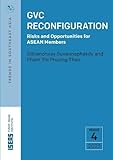GVC Reconfiguration / Sithanonxay Suvannaphakdy, Thi Phuong Thao Pham.
Material type: TextPublisher: Singapore : ISEAS Publishing, [2023]Copyright date: ©2023Description: 1 online resource (84 p.)Content type:
TextPublisher: Singapore : ISEAS Publishing, [2023]Copyright date: ©2023Description: 1 online resource (84 p.)Content type: - 9789815104127
- DS526.7 .T74 2023eb no. 4
- online - DeGruyter
| Item type | Current library | Call number | URL | Status | Notes | Barcode | |
|---|---|---|---|---|---|---|---|
 eBook
eBook
|
Biblioteca "Angelicum" Pont. Univ. S.Tommaso d'Aquino Nuvola online | online - DeGruyter (Browse shelf(Opens below)) | Online access | Not for loan (Accesso limitato) | Accesso per gli utenti autorizzati / Access for authorized users | (dgr)9789815104127 |
Frontmatter -- FOREWORD -- EXECUTIVE SUMMARY -- 1. INTRODUCTION -- 2. ROLE OF ASEAN IN GLOBAL VALUE CHAINS -- 3. RISK LEVELS OF ASEAN’S GLOBAL VALUE CHAINS -- 4. CONCLUSION AND POLICY RECOMMENDATIONS -- ANNEXES -- REFERENCES
restricted access online access with authorization star
http://purl.org/coar/access_right/c_16ec
The COVID-19 pandemic, geopolitical tensions and US-China trade disputes, and the Russia-Ukraine war have increased the risk of global value chain (GVC) disruptions and forced firms to strengthen resilience in their supply chains and operations. MNCs have diversified suppliers, established new production sites, and shifted production closer to consumers. ASEAN countries are becoming increasingly attractive destinations for foreign investors. This paper gauges the position of ASEAN in GVCs and assesses the risks and opportunities of GVC reconfiguration for ASEAN countries. ASEAN countries are increasing their participation in GVCs and raising domestic value-added. The relocation of production sites from China to ASEAN countries could enhance their participation in GVCs. Should MNCs increase the concentration of supplier and buyer markets, ASEAN countries could become more vulnerable to external shocks. In addition, this paper assesses the risk of thirty-five sectors of GVCs in ASEAN countries using value-added trade data from ADB’s multi-region input-output tables (MRIO). Brunei, Cambodia, Indonesia, Laos, the Philippines and Thailand face significant risks of both supplier and buyer market concentrations. The remaining ASEAN countries face the risk of either supplier market concentration or buyer market concentration. Any restrictions on the use of intermediate inputs from the US or China to manufacture goods in ASEAN can cause substantial disruption to ASEAN GVCs. The upstream and downstream GVCs in ASEAN countries are dominated by the US, China and Japan. Extraregional trade integration could be enhanced by linking keysuppliers and buyers in China, the US, and Japan to producers inASEAN countries. Trade policy measures to strengthen ASEAN GVCs should focus on a faster release of perishable goods and intermediate inputs at border checkpoints, accelerating the cross-border paperless trade reforms, promoting the utilization of rules of origins under RCEP, streamlining non-tariff measures, and digitalizing ASEAN GVCs.
Mode of access: Internet via World Wide Web.
In English.
Description based on online resource; title from PDF title page (publisher's Web site, viewed 06. Mrz 2024)


